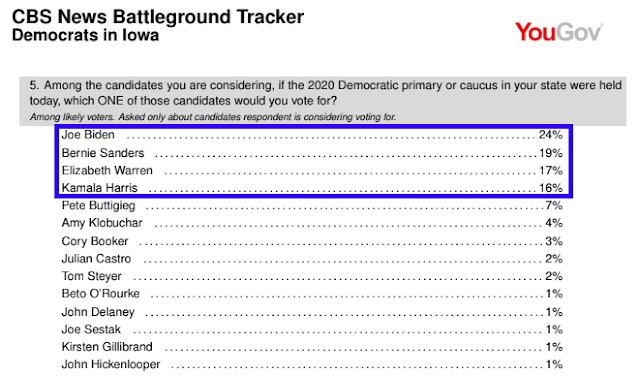And while that aspect of the exercise is on some level helpful, the overall delegate allocation aggregation is less so. And look folks, those behind these monthly updates are up front about this being a snapshot. It is and that is just like the polling on which the delegate projections are based.
But in reality, the nomination process itself is not a snapshot. Invisible primary activity affects Iowa which affects New Hampshire which affects Nevada which affects South Carolina which affects Super Tuesday and so on. The process, then, is not a singular snapshot but a series of them interconnected with each other. By lumping the Super Tuesday and earlier states together like this and producing a hypothetical picture of the delegate allocation, the winnowing process gets smoothed over to a degree that does not match how the allocation and winnowing processes have tended to work during the post-reform era. And the sequence of the process is entirely lost.
And "winnowing process" is a loaded term. In real time -- in the context of primary and caucus voting -- those winnowing pressures manifest themselves in terms of money continuing to come in, prevailing media narratives developing, and on top of both of those, the changing perspectives of prospective primary and caucus voters.
One way to think about this is by looking at the poll results in the earliest three states (Nevada is excluded), but treating them as in a sequence. By doing that the possibility of quick February winnowing appears more likely. In fact, by coincidence, it looks natural.
 |
| Candidates with 1 percent or greater shown Candidates qualifying for statewide delegates shown in the blue box |
In any event, candidates outside of the top four finishers in this hypothetical sequence after the caucuses would find it even more difficult to grab attention in the eight days between Iowa and New Hampshire. In other words, candidates may move on unwinnowed to New Hampshire, but at that point are merely zombie candidates unlikely to clear any delegate-qualifying threshold.
 |
| Candidates with 1 percent or greater shown Candidates qualifying for statewide delegates shown in the blue box |
But also note that the number of candidates qualifying for delegates (at least statewide) has decreased. Harris might peel off a delegate or so in the district count, but those are not the sort of small victories on which presidential nomination survival is typically built. In the scenario where Harris has placed fourth in the first two contests and likely missed out on delegates in New Hampshire, South Carolina (or perhaps Nevada in reality) approaches must win territory for Harris.
Additionally, Biden winning the first two contests with Sanders and Warren respectively placing and showing in both cases with more combined support for Biden would be likely to trigger at least some "one should drop out and endorse the other" chatter ahead of the contests in Nevada and South Carolina. Again that winnowing pressure manifests itself in myriad ways.
 |
| Candidates with 1 percent or greater shown Candidates qualifying for statewide delegates shown in the blue box |
At that point, heading into Super Tuesday, the discussion is likely to lean toward Biden and the identity of the Biden alternative (likely a weakened Sanders). And that Biden-or-not question lodged in the backs of voters' minds is the very essence of the winnowing process. The field can and often does quickly boil down to two viable options regardless of the decisions made in campaigns that are falling behind. Again, candidates can move forward in the hopes of winning delegates in the much more delegate-rich fields of Super Tuesday, but that hope hinges on actually winning votes, votes that are harder to come by once the focus has shifted to the candidates who are viable.
In summation, what delegate allocation aggregations of this sort from CBSNews/YouGov do is build up the idea that more candidates are going to receive more delegates than they are likely to in reality (or have been likely to in past cycles). And the natural extension of that is that delegates splitting in this manner is likely to lead the process in one particular direction: a contested convention. But the polling results in the earliest three states (Nevada is excluded) actually do point to a natural sort of winnowing occurring prior to Super Tuesday. But again, those a snapshots in time -- simultaneous rather than conditional snapshots -- that are going to change to some extent as the invisible primary campaign continues.
--
Follow FHQ on Twitter and Facebook or subscribe for daily updates via Email.

No comments:
Post a Comment